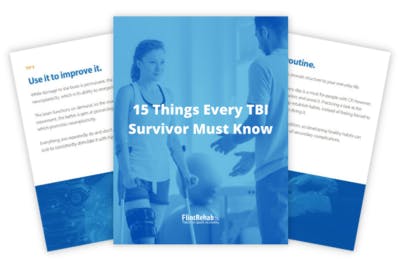No products in the cart.
No products in the cart.
No products in the cart.
No products in the cart.
Home » Neurological Recovery Blog » Traumatic Brain Injury » Dystonia After Brain Injury: Why It Occurs and How to Manage It
Last updated on March 1, 2022

Slow, repetitive, or twisting movements, known as dystonia, may occur after brain injury. Though the exact cause is unclear, researchers believe dystonia results from damage to the parts of the brain that control movement, particularly the basal ganglia. Therefore, dystonia is commonly referred to as a movement disorder.
It’s important to note that while there are other ways an individual can develop dystonia, such as genetics, this article will focus on acquired dystonia that occurs after a brain injury.
We’ll further discuss the most common signs of dystonia, why it occurs, and how to manage dystonia after traumatic brain injury.
To firmly grasp why abnormal movements like dystonia occur after brain injury, it first helps to understand how movement works.
Movement is a combination of agonist and antagonist muscles that work together. The agonist muscles initiate movement via contraction, like a pulley system. The antagonist muscles slow or prevent movement through muscle relaxation which produces an opposing force to the agonist muscles.
For example, to bend your elbow, your triceps must relax so the bicep can move. If the biceps and triceps flex at the same time, abnormal movement can result.
The agonist and antagonist muscles are controlled by the basal ganglia, a cluster of brain cells found inside the brain. The basal ganglia control exactly which and when muscles need to activate or relax. This is done by sending precise inhibitory (stop) or excitatory (go) signals to the appropriate muscle groups.
When areas of the brain responsible for movement are impacted by brain injury, particularly the basal ganglia, the harmonious signaling process is disrupted. As a result, an individual may begin to experience uncontrollable, abnormal movements, or dystonia.
Acquired dystonia after brain injury is divided into three sections, depending on the number of body parts affected.
Early signs of dystonia may include trembling, foot cramping, rapid blinking, or dropping items frequently. The most common areas where repetitive twitching can occur are the eyes, jaw, mouth, neck, arms, and legs. Although less common, dystonia can also cause the torso to bend or writhe.
Oftentimes, dystonia is unnoticeable for several weeks or months after the brain injury. That’s because most signs of dystonia tend to be paroxysmal, meaning they come and go, rather than occur at once.
In this way, dystonia is similar but also distinctly different from spasticity, a condition characterized by muscle stiffening. While both conditions are caused by a disruption of signals from the brain, the onset of spasticity is often rapid, and symptoms may show as early as one week after injury.
Thus, it is essential to speak with your doctor or therapist if you’re experiencing new symptoms after a traumatic brain injury.

Dystonia causes slow, repetitive, or twisting movements which can get in the way of daily living activities. Fortunately, these movements can be effectively managed with proper treatment, when often involves a combination of methods.
The following treatment options can help manage dystonia after brain injury:
Of all the treatment options, physical therapy is generally preferred because it helps rebuild the connection between the brain and muscles by activating neuroplasticity. Neuroplasticity is your brain’s ability to repair itself and create new neural pathways – which is best enhanced through repetitive, therapeutic exercise.
As neural connections improve, dystonia slowly decreases to allow you to move your muscles with greater ease. Some individuals need relief from the symptoms of dystonia before they can exercise comfortably, which is why a combination of treatments may be helpful.
Dystonia is a movement disorder that can occur after a traumatic brain injury. It’s characterized by slow, repetitive, twisting movements that may come and go in episodes.
Partaking in physical therapy can help relieve symptoms of dystonia by promoting neuroplasticity. There are also other management techniques available, and you should talk to your therapist to find the best approach for you.

If you like our content, you’ll love our ebook and newsletters! Get instant access to our TBI recovery tips ebook with 20 pages of helpful advice by signing up below.
You’ll also receive our emails that share survivor stories and more useful TBI recovery tips, which you can opt out of at any time. (We know you’ll love them, too.)
We will never sell your email address, and we never spam. That we promise.


Time with a speech therapist is extremely valuable during recovery, especially if you struggle with communication, critical thinking, or memory after brain injury. Insurance typically covers speech therapy for a fixed amount of time. But once it’s over, recovery is in your hands.
That’s why a team of neuroscientists and clinicians from Boston University created the CT Speech & Cognitive Therapy app. Designed for those recovering from stroke, TBI, or living with neurological conditions, the app contains over 100,000 cognitive exercises that are all available right from your phone or tablet. That’s like having a speech therapist by your side whenever you want!
This app is the perfect fit if you want to improve your speaking, memory, or general mental sharpness. And, it’s affordable at just $29.99/month!
“For the past 6 months, my son has used the app about three times a week. The app is like a virtual therapist, it’s very easy to use, and it gives him immediate feedback.
He now understands things faster, can make decisions with less hesitation, has improved recognition of words, and his confidence is higher. I also find it easy to get in touch with customer service; they pleasantly help out. The whole experience has been great.”
— Miriam
With the CT App, you can get the guidance you need right from your phone or tablet. You can use it on your own or in between sessions with your speech therapist.
Whether you struggle with aphasia, memory loss, or critical thinking, the CT Speech & Cognitive Therapy App can help.
“The CT app has helped me gather my confidence by building on and reinforcing old forgotten skills. It helps to see my percentages increase, and work harder when they decrease. It’s very self-motivating.” -Kathryn
We are confident that this app will help improve your speech and cognitive function after brain injury. Like our recovery tools, the CT App is also covered by our 30-day money-back guarantee.

Do you know these 15 TBI recovery tips?
Get a free copy of our ebook 15 Things Every TBI Survivor Must Know. Click here to get instant access.
Grab a free rehab exercise ebook!
Sign up to receive a free PDF ebook with recovery exercises for stroke, traumatic brain injury, or spinal cord injury below: